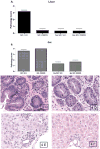The synthetic triterpenoid, CDDO, suppresses alloreactive T cell responses and reduces murine early acute graft-versus-host disease mortality
- PMID: 17448911
- PMCID: PMC4559277
- DOI: 10.1016/j.bbmt.2006.12.453
The synthetic triterpenoid, CDDO, suppresses alloreactive T cell responses and reduces murine early acute graft-versus-host disease mortality
Abstract
Acute graft-versus-host disease (aGVHD) still remains one of the life-threatening complications following allogeneic hematopoietic stem cell transplantation (allo-HSCT). Immunomodulation of alloreactive donor T cell responses, as well as cytokine secretion is a potential therapeutic approach for the prevention of aGVHD. The synthetic triterpenoid, CDDO (2-cyano-3, 12-dioxooleana-1, 9-dien-28-oic acid), exhibits potent antitumor activity and has also been shown to mediate anti-inflammatory and immunomodulatory effects. We therefore wanted to assess the effects of CDDO on early lethal aGVHD. In this study, we found that CDDO significantly inhibited in vitro mixed lymphocyte responses and preferentially promoted the apoptosis of proliferating but not resting alloreactive T cells. Using a full major histocompatibility complex (MHC)-disparate murine aGVHD model, we found that the administration of CDDO immediately after transplantation significantly decreased liver pathology as determined by histologic assessment and prolonged survival in mice. Importantly, administration of CDDO did not adversely impair donor myeloid reconstitution as determined by peripheral blood cell count and the extent of donor chimerism. These findings indicate that CDDO has a significant immunomodulatory effects in vitro and on early lethal aGVHD development, particularly affecting the liver, in a murine allo-HSCT model.
Figures





Similar articles
-
The triterpenoid CDDO-Me delays murine acute graft-versus-host disease with the preservation of graft-versus-tumor effects after allogeneic bone marrow transplantation.Biol Blood Marrow Transplant. 2010 Jun;16(6):739-50. doi: 10.1016/j.bbmt.2010.01.020. Epub 2010 Mar 23. Biol Blood Marrow Transplant. 2010. PMID: 20338256 Free PMC article.
-
Icariin protects against acute graft-versus-host disease while preserving graft-versus-leukemia activity after allogeneic hematopoietic stem cell transplantation.Phytomedicine. 2024 Sep;132:155901. doi: 10.1016/j.phymed.2024.155901. Epub 2024 Jul 18. Phytomedicine. 2024. PMID: 39067193
-
Extracellular Vesicles Released from Human Umbilical Cord-Derived Mesenchymal Stromal Cells Prevent Life-Threatening Acute Graft-Versus-Host Disease in a Mouse Model of Allogeneic Hematopoietic Stem Cell Transplantation.Stem Cells Dev. 2016 Dec 15;25(24):1874-1883. doi: 10.1089/scd.2016.0107. Epub 2016 Oct 24. Stem Cells Dev. 2016. PMID: 27649744
-
Recent Metabolic Advances for Preventing and Treating Acute and Chronic Graft Versus Host Disease.Front Immunol. 2021 Oct 12;12:757836. doi: 10.3389/fimmu.2021.757836. eCollection 2021. Front Immunol. 2021. PMID: 34712243 Free PMC article. Review.
-
Translational Clinical Strategies for the Prevention of Gastrointestinal Tract Graft Versus Host Disease.Front Immunol. 2021 Nov 26;12:779076. doi: 10.3389/fimmu.2021.779076. eCollection 2021. Front Immunol. 2021. PMID: 34899738 Free PMC article. Review.
Cited by
-
The triterpenoid CDDO-Me delays murine acute graft-versus-host disease with the preservation of graft-versus-tumor effects after allogeneic bone marrow transplantation.Biol Blood Marrow Transplant. 2010 Jun;16(6):739-50. doi: 10.1016/j.bbmt.2010.01.020. Epub 2010 Mar 23. Biol Blood Marrow Transplant. 2010. PMID: 20338256 Free PMC article.
-
Immunomodulation and pharmacological strategies in the treatment of graft-versus-host disease.Expert Opin Pharmacother. 2008 Sep;9(13):2305-16. doi: 10.1517/14656566.9.13.2305. Expert Opin Pharmacother. 2008. PMID: 18710355 Free PMC article. Review.
-
The triterpenoid CDDO-Me promotes hematopoietic progenitor expansion and myelopoiesis in mice.Biol Blood Marrow Transplant. 2012 Mar;18(3):396-405. doi: 10.1016/j.bbmt.2011.11.013. Epub 2011 Nov 17. Biol Blood Marrow Transplant. 2012. PMID: 22100978 Free PMC article.
-
A unique tolerizing dendritic cell phenotype induced by the synthetic triterpenoid CDDO-DFPA (RTA-408) is protective against EAE.Sci Rep. 2017 Aug 29;7(1):9886. doi: 10.1038/s41598-017-06907-4. Sci Rep. 2017. PMID: 28851867 Free PMC article.
-
New synthetic triterpenoids: potent agents for prevention and treatment of tissue injury caused by inflammatory and oxidative stress.J Nat Prod. 2011 Mar 25;74(3):537-45. doi: 10.1021/np100826q. Epub 2011 Feb 10. J Nat Prod. 2011. PMID: 21309592 Free PMC article. Review.
References
-
- Fowler DH. Shared biology of GVHD and GVT effects: potential methods of separation. Crit Rev Oncol Hematol. 2006;57:225–244. - PubMed
-
- Murphy GF, Korngold R. Significance of selectively targeted apoptotic rete cells in graft-versus-host disease. Biol Blood Marrow Transplant. 2004;10:357–365. - PubMed
-
- Ferrara JL, Reddy P. Pathophysiology of graft-versus-host disease. Semin Hematol. 2006;43:3–10. - PubMed
-
- Ray DM, Morse KM, Hilchey SP, et al. The novel triterpenoid 2-cyano-3,12-dioxooleana-1,9-dien-28-oic acid (CDDO) induces apoptosis of human diffuse large B-cell lymphoma cells through a peroxisome proliferator-activated receptor gamma-independent pathway. Exp Hematol. 2006;34:1201–1210. - PubMed
Publication types
MeSH terms
Substances
Grants and funding
LinkOut - more resources
Full Text Sources
Other Literature Sources
Research Materials

